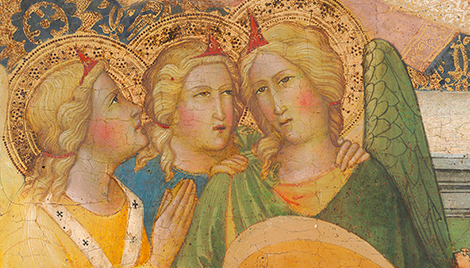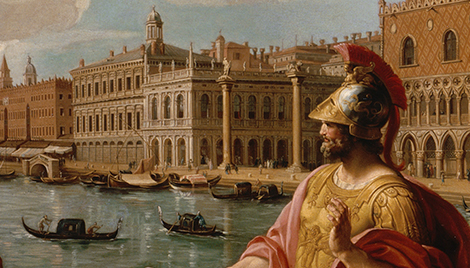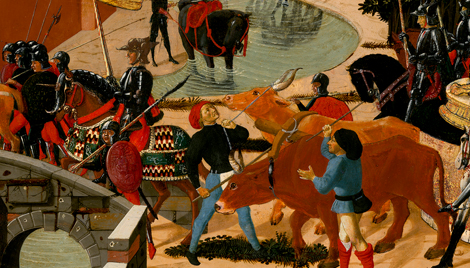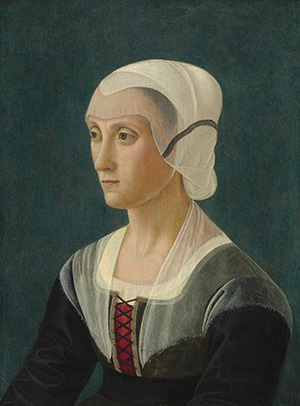Lucrezia Tornabuoni
Lucrezia Tornabuoni
- Artist
- Attributed to Domenico Ghirlandaio
- Artist Dates
- 1449-1494
- Artist Nationality
- Italian
- Title
- Lucrezia Tornabuoni
- Date
- c. 1475
- Medium
- tempera and oil on poplar panel
- Dimensions
- 53.3 x 39.9 cm (21 x 15 11/16 in)
- K Number
- K1725
- Repository
- National Gallery of Art
- Accession Number
- 1952.5.62
- Notes
Provenance
Possibly Palazzo Tornabuoni, Florence, until c. 1850. [1] William Graham [1817-1885], London; (his estate sale, Christie, Manson & Woods, London, 2-3 and 8-10 April 1886, 3rd day, no. 200, as _Portrait of a Lady_, bought in by Agnew's for executors of Graham estate); Kenneth Muir-MacKenzie, 1st baron Muir-Mackenzie [1845-1930], London; [2] by inheritance to his daughter, Dorothea Muir-Mackenzie Hambourg [Mrs. Mark Hambourg], London. (Frank T. Sabin, London), in 1937. [3] (Count Alessandro Contini-Bonacossi, Florence); sold July 1950 to the Samuel H. Kress Foundation, New York; [4] gift 1952 to NGA. [1] That there existed at least one, and probably two, painted panel portraits of Lucrezia Tornabuoni in the fifteenth century is verified by two documents: the inventory of Lorenzo de' Medici's possessions made at his death in 1492 includes mention of "Uno quadro di legname, dipintovi la 'mpronta di madonna Lucrezia" (Marco Spallanzani and Giovanni Gaeta Bertelà, eds., _Libro d'inventario dei beni di Lorenzo il Magnifico_, Florence, 1992: 124), and the 1497 inventory of the household of Lucrezia's brother, Giovanni Tornabuoni, lists "1o quadretto d'una testa e busto di Mona Luchrezia de' Medicj" (Patricia Simons, _Portraiture and Patronage in Quattrocento Florence with Special References to the Tornaquinci and their Chapel in S. Maria Novella_, 2 vols., Ph.D. diss., University of Melbourne, 1985: 1:146; John Lydecker, _The Domestic Setting of the Arts in Renaissance Florence_, Ph.D. diss., The Johns Hopkins University, Baltimore, 1997: 63 n. 84). Given Lucrezia Tornabuoni's preeminent position in 15th century Florence as the wife of Piero de' Medici, the mother of Lorenzo de' Medici, and an accomplished poetess in her own right, it seems likely that both documents refer to portraits of her, but it is possible that the subject of either portrait was instead Lorenzo de' Medici's eldest daughter, also named Lucrezia (1470-after 1550). In his life of Botticelli, Vasari noted a profile portrait of Lucrezia Tornabuoni in the _guardaroba_ of Duke Cosimo I de' Medici (Vasari, _Vite_, 2nd ed., 1567, ed. Gaetano Milanesi, 1876: 3:322), which may well be identical with the portrait of Lucrezia listed in the 1553 inventory of the duke's _guardaroba_: "1o Quadro pittoui Madonna Lucretia di Piero de Medici con cornice dorata" (Transcribed by Herbert P. Horne from documents in the Archivio di Stato, Florence, in _Alessandro Filipepi, Commonly Called Sandro Botticelli_, London, 1908: 365). If it is also the painting mentioned in the 1492 Medici inventory, the NGA portrait, not a profile, would presumably be the one from the Tornabuoni collection. [2] Ellis Waterhouse wrote to Fern Rusk Shapley on 22 July 1980 (in NGA curatorial files) that Graham's daughters could not agree how to divide up what they wanted, so Agnew's bought in at the sale for the family, and the daughters (Lady Hailsham, Lady Horner, Lady Jekyll and Lady Muir-Mackenzie) divided the paintings according to the prices at which they were bought in. Lady Muir-Mackenzie, who died in 1900, must have acquired the NGA painting, although it is her husband's name that is published as the owner. [3] Dr. Alfred Scharf, in a letter of 22 August 1951 to Fern Rusk Shapley (in NGA curatorial files), provided this information and the name of the exhibition at the Sabin gallery in which the painting was shown that year. [4] The Kress Foundation made an offer to Contini-Bonacossi on 17 June 1950 for a group of 125 paintings and one sculpture, including NGA 1952.5.62. The offer was accepted on July 1, and the works of art were released to the Foundation on July 6 after the first payment was received. (See copies of correspondence in NGA curatorial files.)






